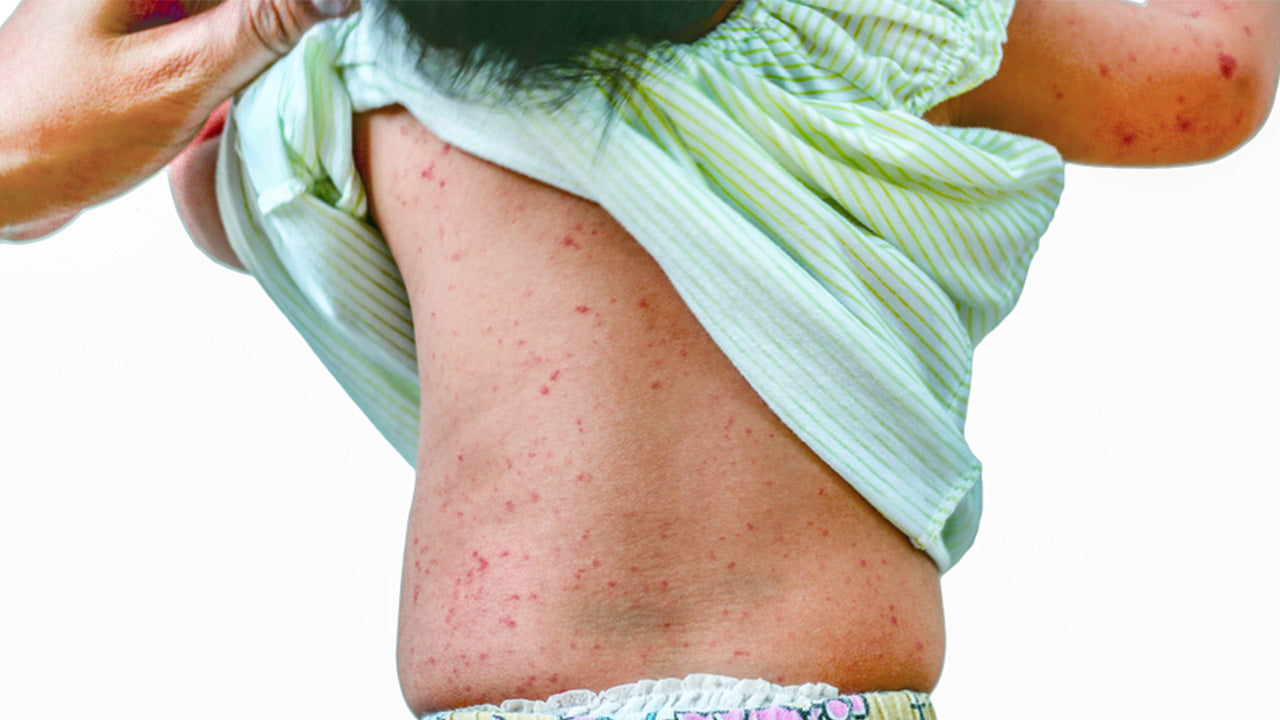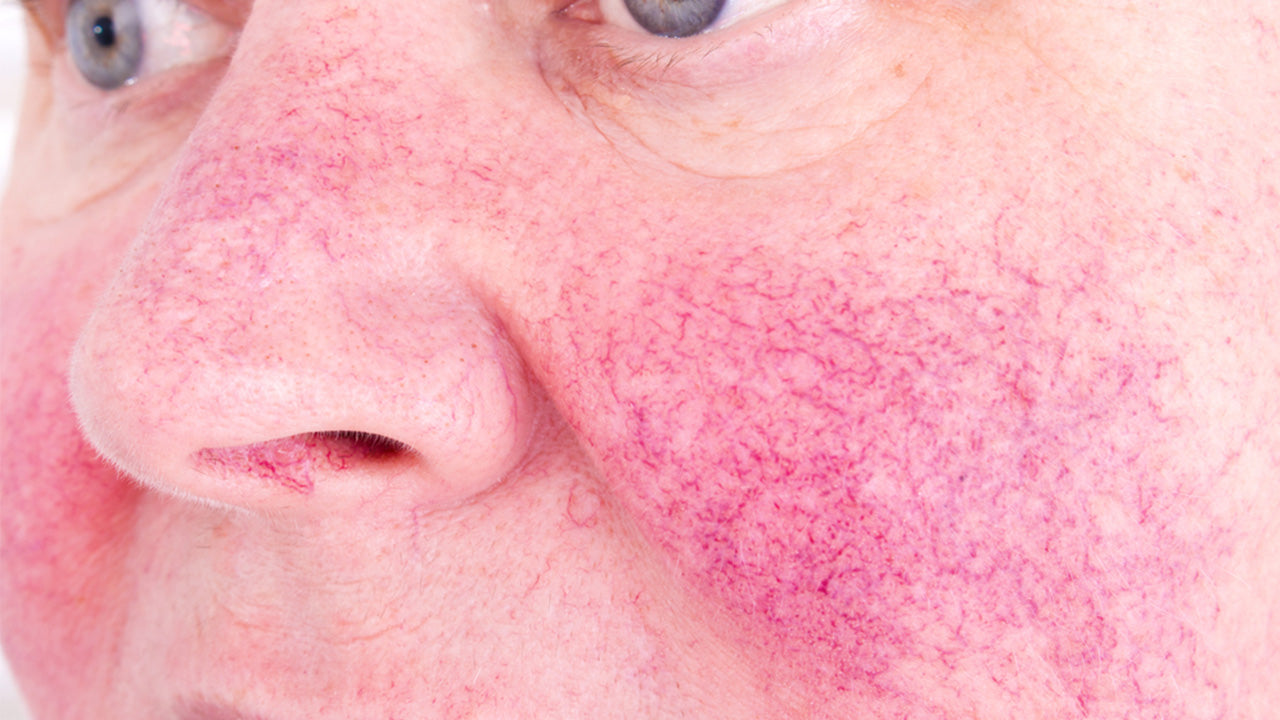Roseola Rash (Sixth Disease) in Children and Adults
 By: by Amino Science
By: by Amino Science

Roseola, a mild viral illness, is seen most often in children between 6 and 24 months old, with an average age of 9 months. It can also affect adolescents, teens, and adults, albeit rarely. Usually, it has a sudden onset and relatively short duration and resolves without any treatment.
Roseola has been called roseola infantum or roseola infantilis to indicate its prevalence among very young children. Because roseola rash appears so suddenly after the fever dramatically departs, the condition may be called exanthem subitum. To distinguish roseola from other childhood illnesses involving skin rashes, it was once named “sixth disease” to indicate that it was the sixth disease young children typically developed and that it lasted about six days.
Cause of Roseola
Roseola spreads from one person to another. The exact cause of this common viral infection is not very well understood. Researchers think that respiratory secretions are responsible. The mild illness incubates for a period of about 9 or 10 days between exposure to the virus and the beginning of symptoms.
Two different viruses cause roseola—usually human herpesvirus 6, also known as HHV-6, and to a lesser extent human herpesvirus 7, also known as HHV-7, the same virus family that causes chickenpox and shingles. While they belong to the same family of viruses that cause genital herpes and cold sores, they are different from them. The sole biological hosts for these two viruses are humans.
According to several studies, there are no apparent symptoms in people who become infected with human herpesvirus 6 and human herpesvirus 7, because the virus gets removed by their immunological systems prior to the development of symptoms. When people do manifest the symptoms of a herpes infection, they usually have no side effects.
If a person’s immune system is not functioning well, he or she might be at risk for encountering complications with the disease. Such patients might be cancer patients getting chemotherapy, people with illnesses impacting the immune system (including AIDS and HIV), and children who are 8 weeks old or younger.
While some experts say that roseola can occur at any time of the year, others say that the spread of the virus is most prevalent during the spring and fall, but the reasons for this remain unknown.
Roseola Symptoms
Symptoms of roseola depend on the age of the infected individual. Most often, the illness occurs in children. Babies and small children normally get a rapid-onset, quickly spiking fever for 3 to 5 days. It can rise to 106 °F, but it is usually logged at an average of 103.5 °F. Additional symptoms may include crankiness, reduced appetite, mild diarrhea, pain in the ear, swelled glands, swelled eyelids, and runny nose. The children carry on with the fever, staying alert and not seeming to be sick.
About one or two days after the fever breaks, the patient quickly gets a rash that is not painful or itchy on the trunk, abdomen, neck, and possibly arms and legs. The rash looks like a cluster of pinkish red spots that turns white when pressure is applied and is either individual 3- to 5-millimeter papules or lesions, or 3- to 5-millimeter macular or flat circles. The noncontagious roseola rash is present for a day or two and does not reappear. Sometimes, the rash is barely visible or not visible at all.
When older individuals contract the viral infection, they usually are sick for a few days with a high temperature and sometimes a nasal drip and loose bowels. Occasionally, the rash starts as the fever subsides.
Roseola can infect adults who were not previously infected as children. As in children, symptoms entail fever, rash, and seizures. Sometimes, there are other symptoms, such as loss of appetite, sore throat, runny nose, and swollen lymph nodes.
Adults with weak immune systems—including elderly people and those undergoing chemotherapy treatments or recent transplants—are more likely to contract the virus. Roseola has the potential of causing serious complications in adults. Meningoencephalitis infects the brain tissue and its surrounding layers, and hepatitis is inflammation of the liver. Taking supplemental amino acids can help strengthen the immune system and protect against inflammation.
Because the immune system is restrained, pregnant woman are exposed to viruses frequently. If a pregnant woman is exposed to the HHV-6 virus, there is a chance of getting the roseola infection. If she has had roseola in her childhood, she would likely be immune and not get it again. While being exposed to roseola and getting infected during pregnancy may have no impact on the mother or child, it could have some risk to the developing fetus. Most likely, the virus would not affect the pregnancy adversely, but possible complications include an increased risk of miscarriage during the first trimester and a possible chance of birth defects if the virus occurs in the later stages of pregnancy.
The tell-tale sign of roseola is the characteristic rash, but physicians may also confirm their diagnosis with a blood sample that tests for roseola antibodies. Laboratory testing exists to demonstrate elevation of antibodies to HHV-6 (or HHV-7). Such testing may be required if the patient’s immune system is compromised.
Febrile Seizures
A sudden, rapid increase in body temperature may cause a seizure, also known as a convulsion. Febrile seizures occur in 3% of children with roseola between 18 months to 3 years of age and in 5% to 35% of children with the illness overall. While frightening, febrile seizures do not usually cause long-term nervous system side effects or brain damage. While it is important to seek medical attention, doctors rarely prescribe anticonvulsant medications for the treatment or prevention of febrile seizures. This type of seizure may run in families.
What to Do in the Case of a Febrile Seizure
When a child appears to be experiencing a seizure, maintain a calm demeanor. Assist the child in getting onto a floor, loosen garments around the child’s neck, ascertain that there are no pointed objects that could injure the child, and move the child onto one side to allow the flow of saliva to come from his or her mouth.
You can create a pillow out of a piece of clothing or a cushion under the child’s head, but nothing should be placed in his or her mouth. Since most of these seizures are likely to last for 5 minutes or less, it is recommended that an adult should just wait for it to end without trying to apply specific treatment.
Children who have seizures should not be left unattended when adults are getting in contact with a physician or an ambulance. When the seizure ends, it is normal for the children to be somnolent and ready to sleep. At that point, contact the child’s doctor to ascertain whether it is necessary to have an immediate examination.
Roseola Treatment
No specific therapy is typically needed for the roseola rash because it is short-lived and resolves spontaneously, but antipyretic medications are beneficial in lowering fever and reducing discomfort, including headache. Recommended medications are acetaminophen (Tylenol) and/or ibuprofen (Advil). Dosage interval for acetaminophen is every 4 hours, and dosage interval for ibuprofen is every 6 hours. Both are equally effective in lowering the fever.
Avoid using aspirin for treating fever in children or adolescents, because it has been implicated in Reye’s syndrome, which is a life-threatening condition that can cause deadly inflammation of the brain and liver. Never sponge anyone with alcohol, because fumes may be harmful when inhaled.
Experts advise keeping a child with the fever comfortable but not overdressed. Overdressing can raise body temperature. A cool bath with a water temperature of about 85 degrees could be therapeutic. When a child starts to shiver when being bathed, simply raise the temperature of the water in the bathtub.
Keeping children well rested and hydrated will enable their bodies to clear the infection. If the fever is not causing discomfort, it is not necessary to treat it, especially if it requires awakening a child.
People of all ages appear to develop a lifelong immunity to HHV-6 or HHV-7. Complications of roseola are rare except in people who have suppressed immune systems. The prognosis for people who contract roseola is excellent without long-term side effects.
Roseola Prevention
Prevention of roseola is challenging. During the incubation period, an infected child is contagious but has no symptoms. A child is most contagious during the high fever, before the rash. General health awareness and avoidance of ill and febrile children will lessen the exposure risk to roseola and other infectious diseases.
Because roseola is a viral infection, antibiotics are of no value. Routine antiviral agents, such as acyclovir, have limited effect and are not recommended.
No vaccine for roseola is available. Since it does not usually cause painful, long-lasting symptoms or complications, numerous scientists believe that the large expenditure necessary to create such a medication would not be worthwhile.
Routine hygienic practices, such as washing hands frequently and avoiding contact with people diagnosed with the fever appear to be the best ways to minimize the risk of contracting the illness. Places where children congregate—such as preschools and daycare centers—need to decontaminate toys and other shared articles while encouraging children and adults to maintain good hygiene.


Up to 25% off Amino
Shop NowTAGS: conditions
Join the Community
Comments (0)
Most Craveable Recipes




 833-264-6620
833-264-6620



















